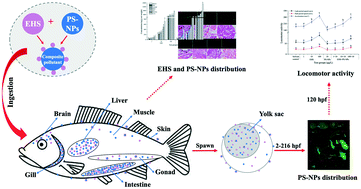Effects of polystyrene nanoplastics on the bioaccumulation, distribution and parental transfer of ethylhexyl salicylate†
Abstract
In this study, the accumulation and distribution of ethylhexyl salicylate (EHS) and polystyrene nanoplastics (PS-NPs) in parental zebrafish (Danio rerio) and offspring and the effects of PS-NPs on EHS bioavailability were investigated. Results showed that both EHS and PS-NPs could accumulate in parents and offspring. The order of cumulative levels of EHS in parental tissues was liver > intestine > gill > brain ≈ gonad > skin > muscle, while PS-NPs levels were highest in the intestine and gill. For co-exposure, PS-NPs significantly increased the cumulative levels of EHS in all tissues except skin, with intestine and liver being the most significant. For F1 embryos, 82% EHS was accumulated in the yolk sac. Some PS-NPs entered the embryo through the chorionic pores, and most of them accumulated in the yolk sac and significantly increased the transfer of EHS from parents to offspring. With the growth and development of F1 embryos, PS-NPs were gradually transferred from the yolk sac to the brain, intestine and other tissues. PS-NPs can mainly target the yolk sac to affect the bioavailability and parental transfer of EHS, which provides an important basis for studying the interactive ecotoxicity and transgenerational toxicity of PS-NPs and hydrophobic organic pollutants.

- This article is part of the themed collection: Nano-bio interactions


 Please wait while we load your content...
Please wait while we load your content...